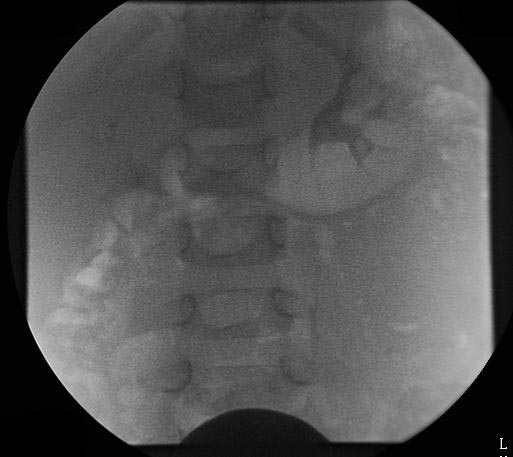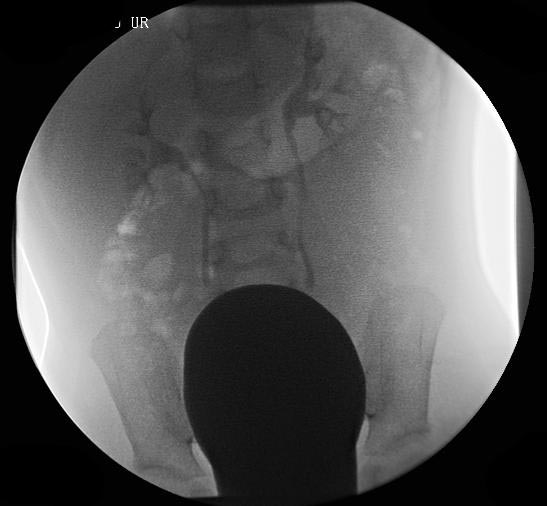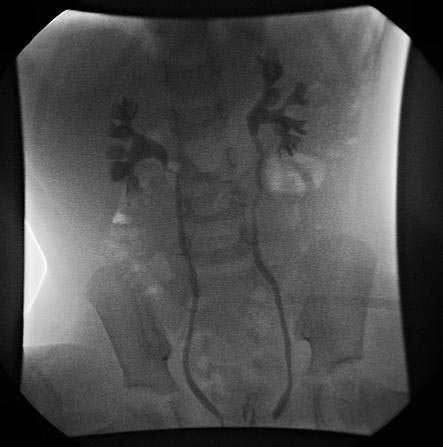Vesicoureteral reflux: Difference between revisions
m (Robot: Automated text replacement (-{{SIB}} +, -{{EH}} +, -{{EJ}} +, -{{Editor Help}} +, -{{Editor Join}} +)) |
Ahmed Younes (talk | contribs) No edit summary |
||
| Line 23: | Line 23: | ||
VUR may be an isolated anomaly or associated with other congenital anomalies such as [[posterior urethral valves]] or complete [[Duplicated collecting system | duplication of the urinary tract]]. | VUR may be an isolated anomaly or associated with other congenital anomalies such as [[posterior urethral valves]] or complete [[Duplicated collecting system | duplication of the urinary tract]]. | ||
{{#ev:youtube|7OqqtSlW9sA}} | |||
==Symptoms== | ==Symptoms== | ||
Revision as of 19:05, 27 May 2017
Template:DiseaseDisorder infobox Template:Search infobox Steven C. Campbell, M.D., Ph.D.
Overview
Vesicoureteral reflux (VUR) is an abnormal movement of urine from the bladder into ureters or kidneys. Urine normally travels from the kidneys via the ureters to the bladder. In vesicoureteral reflux the direction of urine flow is reversed (retrograde).
In the majority of cases, it occurs as a result of a primary maturation abnormality of the vesicoureteral junction or a short distal ureteric submucosal tunnel in the bladder that alters the function of the valve mechanism.
VUR may be an isolated anomaly or associated with other congenital anomalies such as posterior urethral valves or complete duplication of the urinary tract. {{#ev:youtube|7OqqtSlW9sA}}
Symptoms
Vesicoureteral reflux may present before birth as prenatal hydronephrosis, an abnormal widening of the ureter or with a urinary tract infection or acute pyelonephritis. Symptoms such as painful urination or renal colic / flank pain are not symptoms associated with vesicoureteral reflux.
Newborns may be lethargic with failure to thrive, while infants and young children typically present with pyrexia, dysuria, frequent urination, malodorous urine and GIT symptoms, but only when urinary tract infection is present as the initial presentation of VUR.
Causes
In healthy individuals the ureters enter the urinary bladder obliquely and run submucosally for some distance. This in addition to the ureter's muscular attachments help secure and support them posteriorly. Together these features produce a valve like effect that occludes the ureteric opening during storage and voiding of urine. In people with VUR failure of this mechanism occurs with resultant retrograde flow of urine.
Primary VUR
Insufficient submucosal length of the ureter relative to its diameter causes inadequacy of the valvular mechanism. This is precipitated by a congenital defect/lack of longitudinal muscle of the intravesical ureter resulting in an ureterovesicular junction (UVJ) anomaly.
Secondary VUR
In this category the valvular mechanism is intact and healthy to start with but becomes overwhelmed by raised vesicular pressures associated with obstruction, which distorts the ureterovesical junction. The obstructions may be anatomical or functional. Secondary VUR can be further divided into anatomical and functional groups as follows:
Anatomical: Posterior urethral valves; urethral or meatal stenosis.
These causes are treated surgically when possible.
Functional: Bladder instability, neurogenic bladder and non-neurogenic neurogenic bladder Urinary tract infections may cause reflux due to the elevated pressures associated with inflammation.
Resolution of functional VUR will usually occur if the precipitating cause is treated and resolved. Medical and/or surgical treatment may be indicated.
Prevalence
It has been estimated that VUR is present in more than 10% of the population. In children without urinary tract infections 17.2-18.5% have VUR, whereas in those with urinary tract infections the incidence may be as high as 70%.
Age
Younger children are more prone to VUR because of the relative shortness of the submucosal ureters. This susceptibility decreases with age as the length of the ureters increases as the children grow. In children under the age of 1 year with a urinary tract infection, 70% will have VUR. This number decreases to 15% by the age of 12.
Sex
Although VUR is more common in males antenatally, in later life there is a definite female preponderance with 85% of cases being female.
International Classification of Vesicoureteral Reflux
- Grade I – reflux into non-dilated ureter
- Grade II – reflux into the renal pelvis and calyces without dilatation
- Grade III – mild/moderate dilatation of the ureter, renal pelvis and calyces with minimal blunting of the fornices
- Grade IV – dilation of the renal pelvis and calyces with moderate ureteral tortuosity
- Grade V – gross dilatation of the ureter, pelvis and calyces; ureteral tortuosity; papillary impressions
The younger the age of the patient and the lower the grade at presentation the higher the chance of spontaneous resolution. Most (approx. 85%) of grade I & II cases of VUR will resolve spontaneously. Approximately 50% of grade III cases and a lower percentage of higher grades will also resolve spontaneously.
Diagnosis
The following procedures may be used to diagnose VUR:
- Nuclear cystogram (RNC)
- Flouroscopic voiding cystourethrogram (VCUG)
- Ultrasonic cystography
- Abdominal ultrasound
An abdominal ultrasound might suggest the presence of VUR if ureteral dilatation is present; however, in many circumstances of VUR of low to moderate severity, the sonogram may be completely normal, thus providing insufficient utility as a single diagnostic test in the evaluation of children suspected of having VUR (such as those presenting with prenatal hydronephrosis or UTI. VCUG is the method of choice for grading and initial workup, while RNC is preferred for subsequent evaluations as there is less exposure to radiation. A high index of suspicion should be attached to any case a where a child presents with a urinary tract infection, and anatomical causes should be excluded. A VCUG and abdominal ultrasound should be performed in these cases.
(Images shown below are courtesy of RadsWiki)
-
VCUG demonstrating bilateral Grade III vesicoureteral reflux
-
VCUG demonstrating bilateral Grade III vesicoureteral reflux
-
VCUG demonstrating bilateral Grade III vesicoureteral reflux
Treatment
Medical treatment is the preferred mode of management but surgical interventions may be necessary. Medical management is recommended in children with Grade I-III VUR as most cases will resolve spontaneously. A trial of medical treatment is indicated in patients with Grade IV VUR especially in younger patients or those with unilateral disease. Of the patients with Grade V VUR only infants are trialed on a medical approach before surgery is indicated, in older patients surgery is the only option.
Medical Treatment
Medical treatment entails low dose antibiotic prophylaxis until resolution of VUR occurs. Antibiotics are administered nightly at half the normal therapeutic dose. The specific antibiotics used differ with the age of the patient and include:
- Amoxicillin or ampicillin - infants younger than 6 weeks
- Trimethoprim-sulfamethoxazole (co-trimoxazole) - 6 weeks to 2 months
After 2 months the following antibiotics are suitable:
- Nitrofurantoin{5-7mg/kg/24hrs}
- Nalidixic acid
- Bactrim
- Trimethoprim
- Cephalosporins
Urine cultures are performed 3 monthly to exclude breakthrough infection. Annual radiological investigations are likewise indicated. Good perineal hygiene, and timed and double voiding are also important aspects of medical treatment. Bladder dysfunction is treated with the administration of anticholinergics.
Surgical Management
A surgical approach is necessary in cases where a breakthrough infection results despite prophylaxis, or there is non-compliance with the prophylaxis. Similarly if the VUR is severe (Grade IV & V), there are pyelonephritic changes or congenital abnormalities. Other reasons necessitating surgical intervention are failure of renal growth, formation of new scars, renal deterioration and VUR in girls approaching puberty.
There are three types of surgical procedure available for the treatment of VUR: endoscopic (STING procedure); laparoscopic; and open procedures (Cohen procedure, Leadbetter-Politano procedure).
References
- Atala. A, Keating. M, in Campbells Urology 8th ed. Pgs 2053-2094
- Bailey RR: The relationship of VUR to UTI and chronic pyelonephritis-reflux nephropathy. Clin Nephrol 1973;1:132
- Baker et al, Relation of age, sex and infection to reflux: Data indicating high spontaneous cure rate in paediatric patients. J Urol 1966;95:27
- Duckett JW: VUR a "conservative analysis." Am J Kidney Dis 1983;3:139
- Hodson CJ, Edwards D: Chronic Pyelonephritis and VUR. Clin Radiol 1960;11:219
- King et al: Natural history of VUR: Outcome of a trial of non-operative therapy. Urol Clin North Am 1974;1:144
- Ring E et al: Primary VUR in infants with a dilated fetal urinary tract. Eur J Pediatr 1993;152:523
- Sargent MA: what is the normal prevalence of VUR? Pediatr Radiol 2000;9;587
- Smellie JM, Normand ICS: The clinical features and significance of UTIs in children. Proc R Soc London 1966;59:415
- Walker et al: Screening schoolchildren for urologic disease. Pediatrics 1977;60:239


